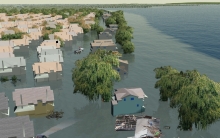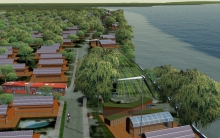Is seeing really believing when it comes to climate change? This coming spring, Dr. Stephen R. J. Sheppard with their students will examine this topic through a unique course being offered at UBC. Visualizing Climate Change (CONS 210 Section 101) will widen the lens on climate change, using the universal appeal of visual media to illustrate the big picture and focus on possible solutions. The course has no prerequisites and is geared toward second and third year undergraduate students from the arts and sciences, who are interested in climate change and exploring their educational options in this area.
Learning with visual media
In this wide-ranging course, students will study the latest climate change research using everything from scientific charts and maps to Hollywood movie special effects and video games. Part of the course will be delivered using science-based 3D visualizations, to demonstrate how recognizable locations across Canada, such as the North shore mountains or coastal communities, could look in the future with the effects of climate change and human responses.
“Humans are visual animals, we’re designed to read landscapes and learn by seeing. We know a picture is worth a thousand words, and we’re translating the concepts and complexities of science into pictures that people can process much more easily,” says Dr. Sheppard, a well-known researcher in the field of visualization from UBC’s Department of Forest Resources Management and Landscape Architecture program.
 Climate change is a complex, multi-faceted—and often overwhelming—topic. Dr. Sheppard says communicating climate science and social impacts using compelling pictures and maps of familiar places or things can clarify the issue and help people grasp the broader implications of climate change. “Visual tools make climate change tangible and real for people, and I suppose the other thing is, people think they’re cool.”
Climate change is a complex, multi-faceted—and often overwhelming—topic. Dr. Sheppard says communicating climate science and social impacts using compelling pictures and maps of familiar places or things can clarify the issue and help people grasp the broader implications of climate change. “Visual tools make climate change tangible and real for people, and I suppose the other thing is, people think they’re cool.”
 Natural disaster movies and news headlines about floods or droughts are climate change visuals many students are familiar with. These images often portray extreme scenarios or focus on one aspect of climate change, such as melting polar ice caps, and they can mislead public perceptions. Dr. Sheppard says such media are often not science-based and exclude key data on the emerging effects of climate change much closer to home, in fields like ecology and conservation, agriculture and food production, energy supplies, and community design.
Natural disaster movies and news headlines about floods or droughts are climate change visuals many students are familiar with. These images often portray extreme scenarios or focus on one aspect of climate change, such as melting polar ice caps, and they can mislead public perceptions. Dr. Sheppard says such media are often not science-based and exclude key data on the emerging effects of climate change much closer to home, in fields like ecology and conservation, agriculture and food production, energy supplies, and community design.
The images above visualize two alternative futures for a coastal community, showing: 1) effects of sea level rise and storm surge late in the century in a continuing high-carbon world; and 2) possible resilient community adapted to sea level rise in a lower carbon world. (Images courtesy of David Flanders, Collaborative for Advanced Landscape Planning, UBC).
Collaborating across disciplines to find solutions
Studying the natural and social science of climate change requires collaboration between many types of scientists and stakeholders, as reflected in Dr. Sheppard’s research with government, communities, and other groups beyond the University. Through the course, he will collaborate with a team of scientists and experts from multiple disciplines and take a systems-thinking approach, working as a team with students.
“We want the scientists who can bring knowledge of critical climate change issues to sit down and mix it up with people that are thinking about sociology, or arts, or film studies, and solve some of these problems together, because we’re not going to solve them in silos,” Dr. Sheppard says. “We want to get students engaged in the dialogue. Solutions can emerge if people are well-informed and invited to offer their opinions, in addition to what the experts, scientists and policy-makers can contribute.”
Interactive learning
Although climate change information isn’t always positive, the course will be solutions-focused, emphasizing hands-on learning and exploration. Students will have an opportunity to interact with experts conducting ground-breaking climate change research, and discuss how climate change impacts both their personal and professional lives, and what they can do to be part of the solution.
The course will also feature interactive tools such as Google Earth, and real-time surveys of student perceptions and ideas.
Looking into the future
One crucial objective is to connect present climate change action to future consequences over the next 100 years. “One of the things I hope students can get out of courses like this is a sense of urgency about getting to the solutions. We have to start moving very quickly as a society, in the next 10 to 12 years, to cut our carbon footprints if we want to stabilize the climate. Students have to grapple with a real mix of timeframes, that’s why the course uses different future scenarios,” says Dr. Sheppard.
Part of understanding climate change is examining it on both a local and a global scale. “We’re going to have a mix of professors and experts teaching some of the sessions throughout the term,” he says. “I think this will enable students to get in quite deep on certain aspects of climate change, but also to see the links and trade-offs in the big picture.”
Visualizing Climate Change promises to be an eye-opening and motivating course that will take students on an academic journey unlike other courses they’ve taken. “Many students that I talk to are very concerned about climate change and sustainability,” Dr. Sheppard says. “We want to harness that concern and help them channel it into something positive that they can do.”
Story by Madelen Ortega, UBC Sustainability website writer
For information on other sustainability-oriented courses and programs, visit the Sustainability Education Resource Centre or Email us for an advising appointment.